17th April, 20235 Min Read
Tips To Shoot A Stunt Sequence Under Budget
17th April, 20235 Min Read

DECODING THE WAYS TO SHOOT A STUNT SEQUENCE EFFECTIVELY
Don’t you think stunt sequences have evolved to greater extents in the cinema industry? Yes! This is an era of VFX that delivers realism at its best.
Have you ever wondered how all of these would cost in terms of production? The most prevalent thought that goes around is “VFX is expensive” but the reality is otherwise. Because these visual effects can cut down the money involved in creating dupe sets, stunt sequences like bombs, crashes, jumping and many more.This broadened the imagination limit, realism, grandeur in cinema. Read more to get into the details of how one can shoot a stunt sequence under budget.
Proficient Team
Choosing the right team that best suits your requirements can give you positive results without compromising on the goals. Experienced professionals from various niches can communicate effortlessly without any lag in the shooting process. By this the shooting process becomes easier & efficient.
A skilled team can really make a difference when it comes to shooting a stunt sequence. An experienced artist can ace a scene without many retakes. The understanding of the scene & enacting with ease majorly reduces all the extra efforts in terms of retakes, background movements, and so on.
Pre-planning & Rehearsing
Realism comes with recreating even the minute details. In order to achieve this the stunt director has to be keen with their visuals and ensure the presence of the VFX team throughout the shoot. This will help in capturing the details at the right angles and moments.
Working on a storyboard before getting to the shoot will help to curate the visuals in order. This storyboard will help all the members of the team to understand & work towards achieving the same. Following this step will save you a lot of time & effort. Storyboarding also helps in the sequencing the film in order. This will further avoid confusions and can enable the directors to prioritize the shots with respect to time constraints.
In order to get the perfect shot, the actor has to practice to perfection. This will reduce retakes and help us get the frame & angle as planned initially. Coordinating with the VFX team will help the directors to capture the appropriate frames which make the post-vis process smooth & efficient.
Ensuring safety in the sets while shooting a stunt sequence is one of the most primary aspects to look after. Rehearsing the stunt moves diligently will help in the flow of the sequence & avoids any lag. Using a professional stunt double for complicated scenes will avoid causing any kind of injuries. Following these will result in efficient output and proportionally reduces the retakes and time consumption.
Framing
The pre-planning & rehearsing of scenes will help the director to set the frames accordingly. Every shot has to be planned beforehand known as pre-vis, so that doesn't disrupt the flow of the sequence. The artist movements, background movements, camera movements have to be discussed and planned earlier to get the perfect shot. A stunt scene requires a lot of physical activities happening throughout the sequence, which involves actions (Guns, Cars, Running, Driving, Crashing, Bombing). Pre-vis helps to articulate the sequence & cuts down the cost of retakes or change of sequences. Having a clear vision of what has to be captured can reduce the volume of shots & improves the quality of shots invariably.
Techniques & Properties
Artists are multifaceted & highly talented but when it comes to a stunt sequence it is always wise to have a stunt double or dupe.
We can present an original fight scene by using green screens if required, jarring effects, high frame rates, recorded presets & more to create a stunt scene.
Investing in durable properties is advisable as they are highly durable and cost-efficient compared to real properties. Synthetic properties are reusable and help in major cost cutting when it comes to stunt scenes. Using put together techniques for bombing, crashing, jumping, and more will consume less time and the rates of these properties are cheap compared to original properties.
Safety
Pre-planned stunt choreographies & intensive practice sessions will prevent the artist from facing injuries or accidents while performing. This will affect the production process and slow down the shooting schedule. All the necessary first aid services have to be present inside the shooting space to avoid complications.
Monitoring
When it comes to stunt scenes, to make it real & relatable it is always advisable to have a VFX supervisor on board right from the storyboard stage. The VFX perspective to a film caters to minute detailing, angles, effects added in shots, properties, placements & more. This will enhance the quality of the shots as the VFX explores the odds and present a appropriate approach to shoot the scene. With this can avoid a lot of post-vis work which results in an effortless editing process.The film director and the VFX specialist have to work hand in hand to deliver the desired results.
Conclusion
Follow these hacks and put in practice to see a vast difference in your shooting approach and to attain incredible results while shooting a stunt sequence. These pointers & hacks on VFX will help you speed up the post production process, enhances the quality of shots, reduces costs & time with utmost safety.
Behind Every Stunning VFX: The Art of Previsualization
20th November, 20244 Mins

Do you remember the 2019 movie, the one that swept us through joy, heartache, grief, and awe in a single journey? The Lion King! Remember the stampede and the fight between Simba and Scar? These scenes used the previsualization method, in which hand-drawn storyboards and early 2D animations were used to create the dramatic confrontation act and set the tone for the final 3D-rendered scene.
Previsualization, or previs, was used in these scenes to create lifelike animal movements and behaviours within the realistic African savanna environment. Curious to know more about how Previsualization in films works? Let’s explore further and learn its importance in the VFX process.
What is Previsualization?
Previsualization, also referred to as previs, is a method used in the media or film industry to create and visualize complex scenes before the actual production begins. Like the filmmaker of Jurassic Park, Steven Spielberg quoted,
‘’Pre-visualization is the filmmaker’s crystal ball, revealing the future of a film before a single frame is shot.’’
Basically, it's a filmmaker's sneak peek into how a scene will look before all the cool effects and actions are added.
Types of Previsualization
Previsualization comes in various types, each serving a unique purpose in bringing a scene's vision to life before the filming begins. Let’s have a look at the three most common ones:
Storyboards
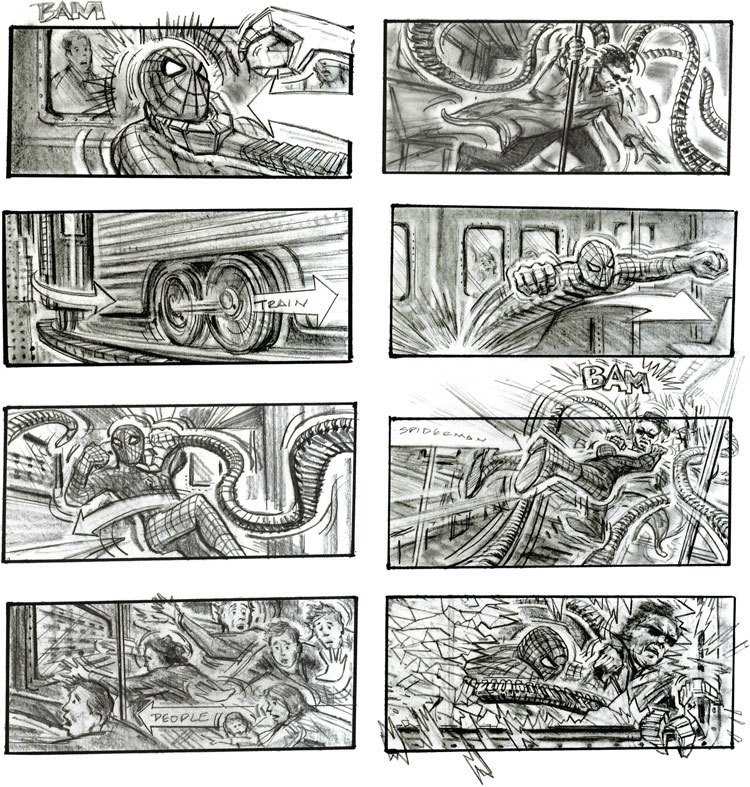
Example of Spiderman-2 storyboard, Source
These consist of a series of digital or hand-drawn images that represent a film's visual sequence. They illustrate a specific shot or a moment in the movie, accompanied by camera angles, essential actions, or dialogue.
There are two kinds of storyboards: traditional and digital. Traditional ones are hand-drawn by a storyboard artist and quick to produce and iterate, perfect for initial planning. Digital storyboards use software and digital tools and can incorporate basic effects and shading. Watch this to understand the early storyboard from the Lord of the Rings Extended Home Release.
Animatics
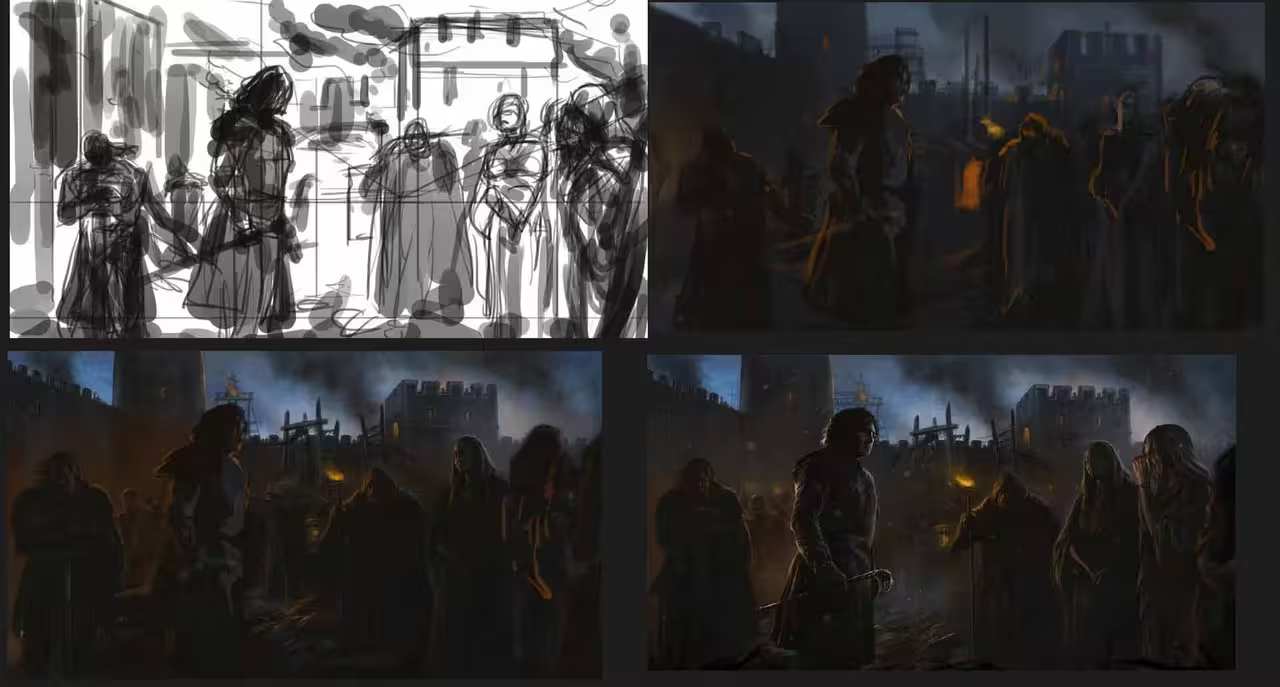
These animated storyboard versions give a rough idea of a scene's timing and motion. Sound, movements, and sometimes temporary dialogue can be added to provide a more realistic view of how a scene would unfold.
Basic animatics involves simple animation of the storyboard frames, which helps in understanding the pace and rhythm of the scene. Advanced animatics can include basic 3D models, sound effects, and voiceovers. Animatics are particularly useful during the editing phase. Check out this video to get an idea of previsualization animatics.
Shot Lists
These detailed documents describe every technical shot for a scene. They are essential for a director and cinematographer, ensuring no shots are missed.
Shot lists include technical details such as camera angles, equipment such as drones, cranes, and lenses, movements like tracking shots or titles, duration of each shot, and notes on the actor's positions or special effects.Learn more about shot lists in previsualization at this link.
Importance of Previsualization
Filming a scene can be a bumpy ride, but previsualization can help smooth the ride. We have listed a few reasons why previsualization in films is vital in the VFX process.
-
Improve creative control
Previsualization is highly beneficial to cinematographers and directors to refine their ideas and cinematic vision before the shooting begins. It also allows you to experiment with light effects and camera angles. It gives the opportunity to fine-tune sequences, prototype complex VFX shots, experiment with the integration of CGI elements, and produce more polished products.
-
Streamlines production process
Previsualization provides a clear road map for the VFX artists to plan shots and sequences. Efficient visualization leads to a smoother workflow, as teams know precisely what will be created or captured. Thus, it minimises resource wastage and helps create high-quality outputs within the given timeframe.
-
Boost collaborative work
It fosters teamwork among various artists, allowing everyone to understand the project's goals and giving them the opportunity to add their input early on. This reduces the chances of costly mistakes and misunderstandings. It also encourages clear communication through previsualization tools.
-
Budget management
Previsualization helps manage VFX and film budgets by spotting challenges early on. Digital previews and storyboards can save costly reshoots, time, and resources. This foresight ensures efficient use of the budget for each VFX shot.
Let’s Help you Achieve your VFX with Flawless Previsualization
By now you would have understood that previsualization does not only benefit the director or the VFX artist, but it also helps foster collaborations, manage budgets, and streamline workflow. With the right previsualization partner, like Knack Studios, you can now create compelling narratives and bring your artistic visions to reality.
Behind the Scenes: The VFX Journey of Saripodhaa Sanivaaram
12th November, 20245 Mins

The Art of VFX: What Went into Saripodhaa Sanivaaram
Directed by Vivek Athreya, Saripodhaa Sanivaaram casts Nani as Surya, a man with a double life—an ordinary insurance agent from Monday to Friday and a vigilante on Saturdays! Opposite him is SJ Suryah, a ruthless Police Officer named Dayanand. The plot revolves around social justice, anger, and fighting personal demons. What truly sets this film apart is its intense writing and extraordinary performances from Nani and SJ Suryah.
In such action dramas, VFX is more than just a tool! It is essential for creating engaging and immersive experiences. It enables filmmakers to create spectacular scenes without compromising safety. From digital layering to background augmentation, we used various methods to create a rich cinematic experience allowing them to feel the adrenaline and emotion of characters!
During the post-production, we mapped out the VFX for the film’s plot without overpowering the performances. We balanced out the VFX and live-action in a way that keeps the film grounded yet visually elevating!
Background Augmentation:
We used background augmentation to extend the set pieces seamlessly. We digitally extended specific environments to enhance their scale and mood to match the emotional tone of each scene. Many scenes in the movie take place in Sokulapalem, a small area,where adding elements helps capture a panoramic view of the town.
Certain scenes of the film featured rain. But filming in the rain can be quite tricky, right? Instead of relying only on practical effects, we used VFX to create realistic rain that felt like a natural part of the environment.
Color Grading and Lighting
The movie has two distinct worlds - Surya’s controlled weekday life and chaotic Saturday vigilante persona! Surya’s weekday is calm, with bright colours, while his Saturday persona is full of energy and anger! With VFX, we heightened the contrast using digital layering to enhance the differences.
One of the standout aspects of the film is the use of colour to convey deeper emotions! This manipulation of light and colour draws the audience into Surya’s world. For instance, we used red as a recurring colour to symbolize anger and intensity . Maintaining the vibrancy of the red colour was essential in telling Surya’s Story.
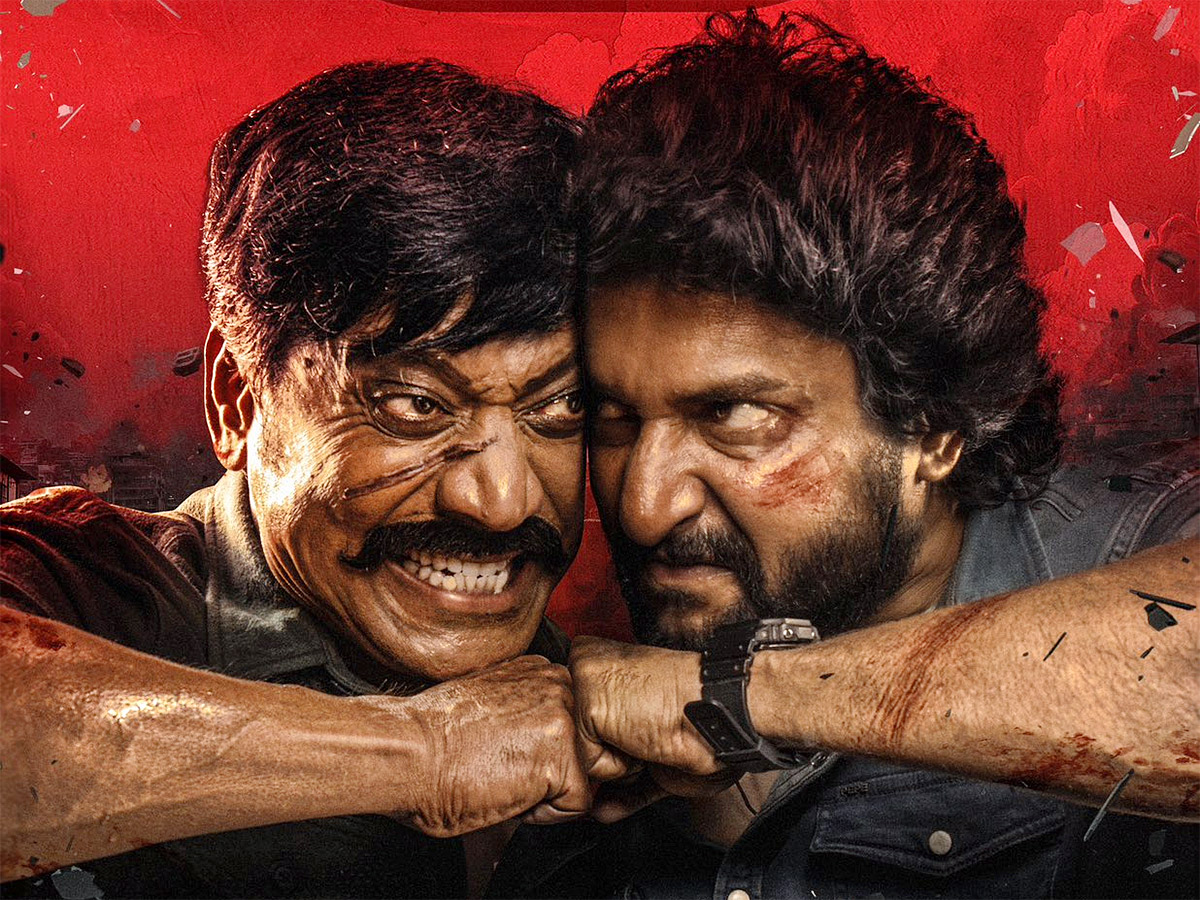
Stunt Sequences
The film's highlight is the adrenaline-pumping action sequences where VFX plays a crucial role!
There’s an instance where Nani’s character gets struck on the head with a bottle, shattering it into tiny pieces. TBH, staging a scene like this without injury is very challenging as the glass pieces are hazardous, especially with the risk of sharp fragments. Here’s where VFX steps in, enabling the filmmakers to create a realistic effect without compromising safety.
The climax of Saripodhaa Sanivaaram is the ultimate showdown between Surya and Dayanand. In this scene, we see Nani’s character with his wrist ignited with fire, symbolizing the rise of courage among the people of Sokulapalem. But the fact is: that fire wasn’t real! We created the fire effect over the live footage with VFX layering techniques, ensuring the flames look so real that no one guesses it! This creative use of VFX draws the audience in!!
Check out this video showcasing all the scenes where VFX brought Saripodhaa Sanivaaram to life
Without these carefully crafted VFX layers, the action might have felt more straightforward, but with them, an extra spark (quite literally!) keeps the audience at the edge of their seats. This is what VFX does best: it elevates reality, adding depth and excitement to action scenes, making them look and feel alive!
In a film where emotions run high, and justice is dealt with fists, VFX ensures that every punch lands and every tear feels real!
That’s how visual effects elevate storytelling to a whole new level! They add depth, excitement, and visual flair, bringing viewers closer to the characters’ journey and uplifting every emotion. The result? An immersive and emotionally resonant film experience.
Ready to see how VFX can transform your next project? Reach out to Knack Studios, and let’s make it happen!
The Birth of Visual Effects in Cinema
8th December, 20235 mins

Unveiling the Enchantment: Georges Méliès
In the nascent days of cinema, amidst the crackling excitement of moving pictures, one man stood as a magician behind the lens, weaving tales of wonder and enchantment through the art of filmmaking. Georges Méliès, a visionary filmmaker and illusionist, transformed the cinematic landscape, birthing the very essence of visual effects and unleashing the boundless potential of storytelling through the magical medium of film.
The Journey Begins: From Stage to Screen
Georges Méliès, born on December 8, 1861, in Paris, was initially captivated by the world of stage magic. As an accomplished magician, he dazzled audiences with his performances, often incorporating intricate illusions and spectacular effects. Méliès' transition from the stage to the emerging world of cinema happened almost serendipitously when he attended the Lumière brothers' first public screening of the cinematograph in 1895.
Pioneering Innovations in Filmmaking
Driven by an insatiable curiosity and a flair for innovation, Méliès didn’t merely see the camera as a recording device but as a tool to create fantasies. His groundbreaking approach to filmmaking introduced numerous techniques that became the bedrock of visual effects in cinema.
Trick Photography: Méliès pioneered the art of 'trick photography' – a term coined to describe his innovative use of special effects. By manipulating the camera, multiple exposures, and meticulous set designs, he conjured up fantastical scenes that transported viewers to worlds beyond imagination.
Theatre of Illusions: Drawing from his background in stage magic, Méliès seamlessly blended theatricality with cinema. His use of elaborate sets, trap doors, and meticulously crafted props transformed the screen into a canvas where the impossible became possible.
Iconic Creations and Enduring Legacy
Méliès' visionary works are etched in the annals of cinematic history, each frame a testament to his boundless creativity. One of his most iconic films, "A Trip to the Moon" (1902), remains a hallmark of early cinema. The iconic image of a rocket crashing into the eye of the moon stands as an indelible symbol of Méliès' imaginative prowess and technical ingenuity.
Despite his groundbreaking contributions, Méliès faced financial challenges, and as the industry evolved, his pioneering spirit gradually faded into obscurity. It wasn’t until later years that his genius was acknowledged, and he was rightfully celebrated as a visionary whose influence resonates through generations of filmmakers.
Legacy and Impact
Georges Méliès' legacy extends far beyond his cinematic innovations. His boundless imagination and audacious approach to storytelling laid the groundwork for future filmmakers, inspiring the likes of Alfred Hitchcock, Tim Burton, and Martin Scorsese. His impact on visual effects and storytelling techniques continues to reverberate in contemporary cinema, serving as a guiding light for artists pushing the boundaries of imagination and technology.
As we celebrate the artistry of modern visual effects and the captivating worlds they create, it’s imperative to pay homage to the luminary whose pioneering spirit set the stage for the enchanting tapestry of visual storytelling that we relish today.
Georges Méliès, the conjurer of cinematic marvels, remains an immortal figure whose legacy transcends time. His boundless imagination and relentless pursuit of enchantment continue to inspire filmmakers, reminding us that within the realm of cinema, the limits of imagination are yet to be discovered.
In the grand tapestry of film history, Georges Méliès stands as a luminary, a visionary whose legacy twinkles like stars in the cinematic sky, forever illuminating the path for generations of storytellers to come.
A Day in the Life of a VFX Artist: What They Really Do
26th November, 20246 Mins

Ever watched the first Iron Man movie and wondered how Tony Stark soared through the sky, dodging missiles and landing with that signature superhero flair?
Take a peek behind the scenes and you’ll notice it’s not just Robert Downey Jr. wearing a fancy suit.
Behind every repulsor blast, mid-air flip, and picture perfect landing, is a team of brilliant VFX artists, turning raw green-screen footage into cinematic gold. Without their magic, Tony’s sleek armor would only look like a bad cosplay.

A VFX artist’s daily grind isn’t just playing with fancy software. It’s a thrilling blend of creativity and technical wizardry. From creating dazzling explosions to breathing life into mythical creatures, they make it all possible. But what does it take to create such larger-than-life scenes? Let’s pull back the curtain and explore a day in the life of the talented VFX artists and their roles in the post production process!
A Day in the Life of a VFX Artist
The typical workday for a VFX artist begins early. Starting with a brief breakfast or a hot cup of coffee, they check their mails and notes for any modifications or additional duties and act on them based on the requirements of the directors or team members. Once they are seated at their desks, their creative process and day-to-day responsibilities will include:
Breaking Down Shots
VFX artists go over each shot or frame and examine them closely to determine any changes and improvements that can be made. For example, when animating a dragon, the artists consider its design, movements, fire-breathing, and interactions with the environment.
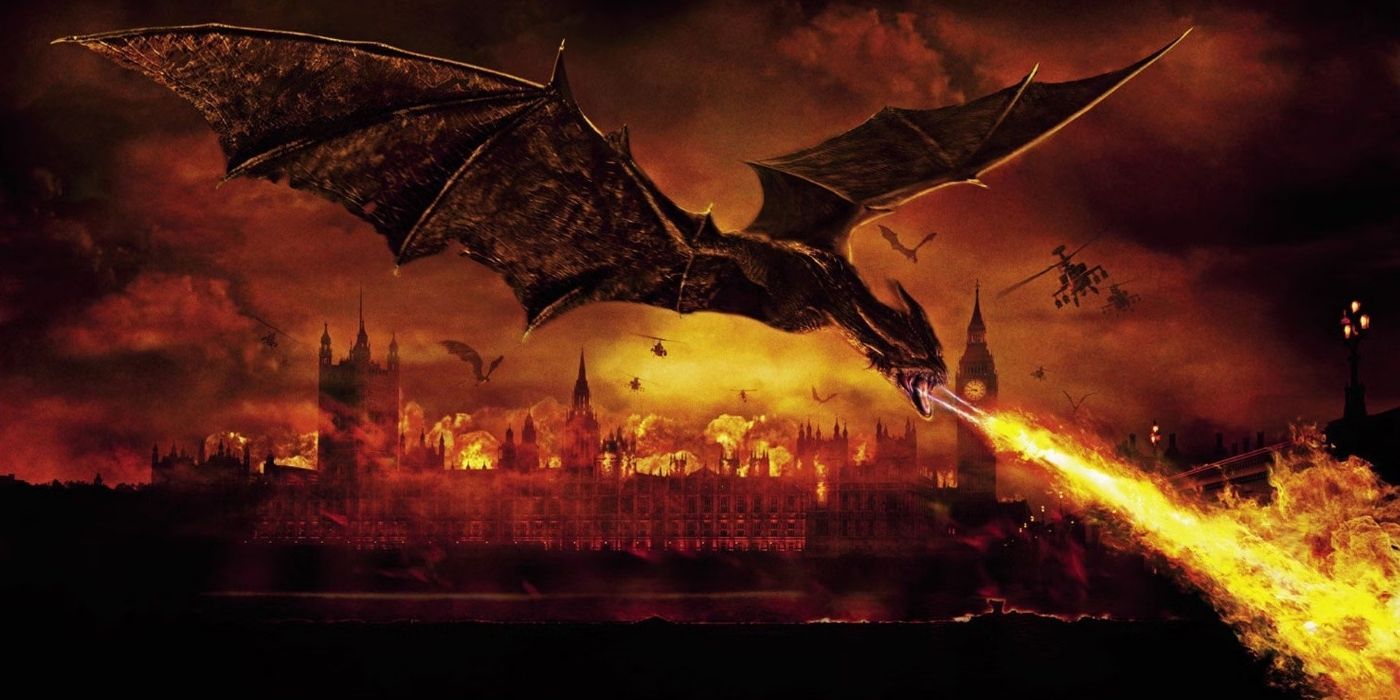
3D Modeling
This is a big part of a VFX Artist’s responsibility where they have to create or refine digital assets being used. In this process, they sculpt 3D objects using specialized softwares. VFX artists use them to create objects, characters, and settings for animation, simulation, and rendering. In the art of filmmaking, 3D modelling plays a key role as is ensures higher consistency in character portrayal.
Animation
Animation in the VFX process involves creating moving images from individual frames, often using techniques like 2D, 3D, or stop-motion. The process isn’t just about movement, it’s storytelling through motion, which also enhances the scope for making movies in unique styles.
Texturing
Texturing is like giving digital objects their “skin.” No one wants to just look at a plain, gray, and unfinished 3D model. Texturing elevates 3D models through addition of colors, patterns, and details like scratches, dirt, etc. So when you look at a rusty robot, a shiny spaceship, or a wrinkled, ancient face, it is all thanks to texturing.
Lighting
This process is about setting the mood with a magical spotlight. Lighting is essential in VFX to make scenes more real, dramatic, and even eerie. From glowing cityscapes to creepy wooden forests, lighting is the step that gives more life and depth to each frame, making every scene more captivating and cinematic. Ever wondered about the secret of Star Wars’ lighting techniques. You can check out this video for deeper insights.
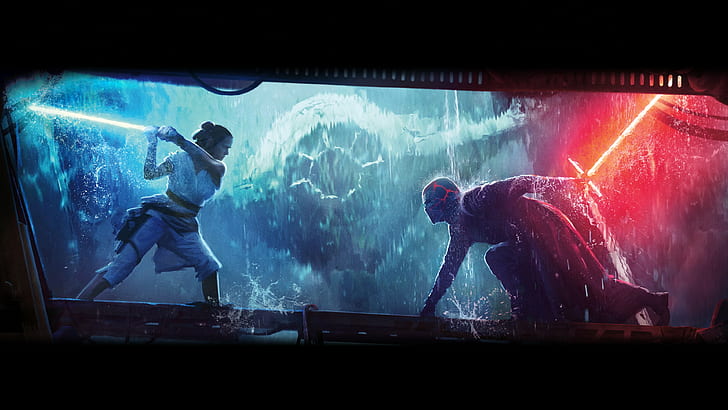
Compositing
The artists ensure all elements blend naturally together and that any green screens are removed flawlessly, creating a cohesive scene. This is a key process of visual effects in filmmaking.
Troubleshooting
Visual effects in filmmaking aren't always smooth sailing as texture glitches or software crashes can happen. Patience is key here and VFX artists ensure all technical issues are resolved to keep the production timeline on track.
Collaboration
The VFX team collaborates with directors, cinematographers, and editors to ensure their work is in line with the director’s vision. Feedback loops are constant, which demands flexibility and the ability to adapt quickly.
Rendering and Reviewing
Finally, VFX artists play the waiting game while the computer generates the final version of their effects, frame by frame. Rendering can take a few minutes and even hours. And a review is conducted after rendering to check if everything has been made as intended.
The daily activities of VFX artists extend beyond their responsibilities. While not at their desk, they may be found playing video games or watching movies for inspiration. Or they could be learning about new softwares and tools to honor their craft and stay ahead of filmmaking developments. After all, this field is constantly changing and requires continuous learning and commitment.
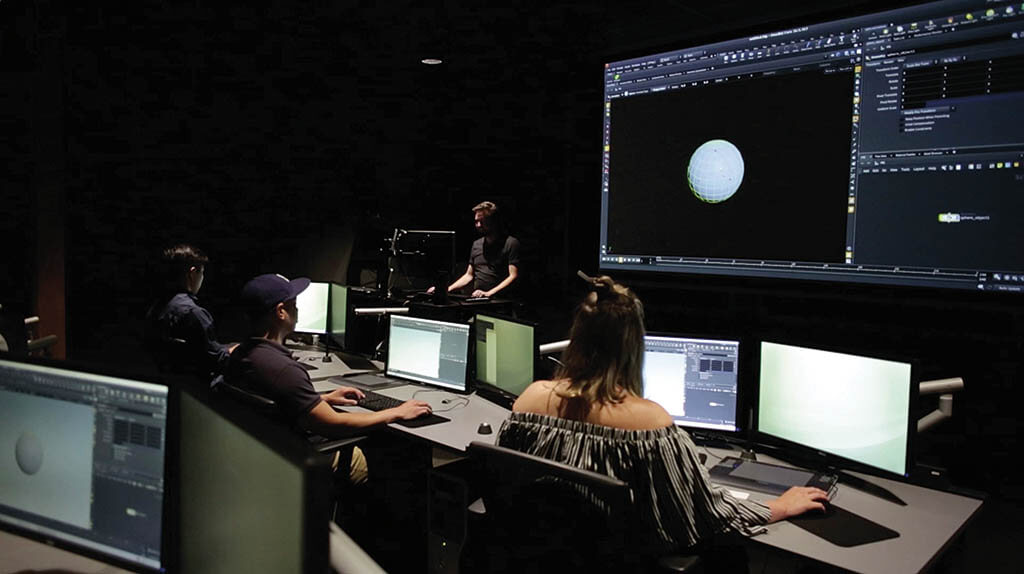
Wrap Up
A VFX artist’s day is a fascinating blend of creativity, collaboration, and technical proficiency. Throughout their day, they build entire worlds from scratch, with patience and extremely high attention to detail. And in the post production process, their work plays a massive role in turning the director’s vision into a reality and helping the film reach critical and commercial success.
If you are an aspiring filmmaker looking to implement top-notch visual effects for your upcoming project, Knack on our doors and we will be there to assist you!
References:
https://www.linkedin.com/pulse/day-life-vfx-artist-farhan-ashik-ftydc/
https://www.onassemble.com/blog/the-vfx-pipeline-your-ultimate-guide-to-the-vfx-workflow
https://www.ftrack.com/en/2022/09/what-is-a-vfx-artist.html
https://www.screenskills.com/job-profiles/browse/games/technical-art/visual-effects-vfx-artist/
Directors & the VFX Team: Crafting Magic Through Collaboration
5th December, 20243 Mins

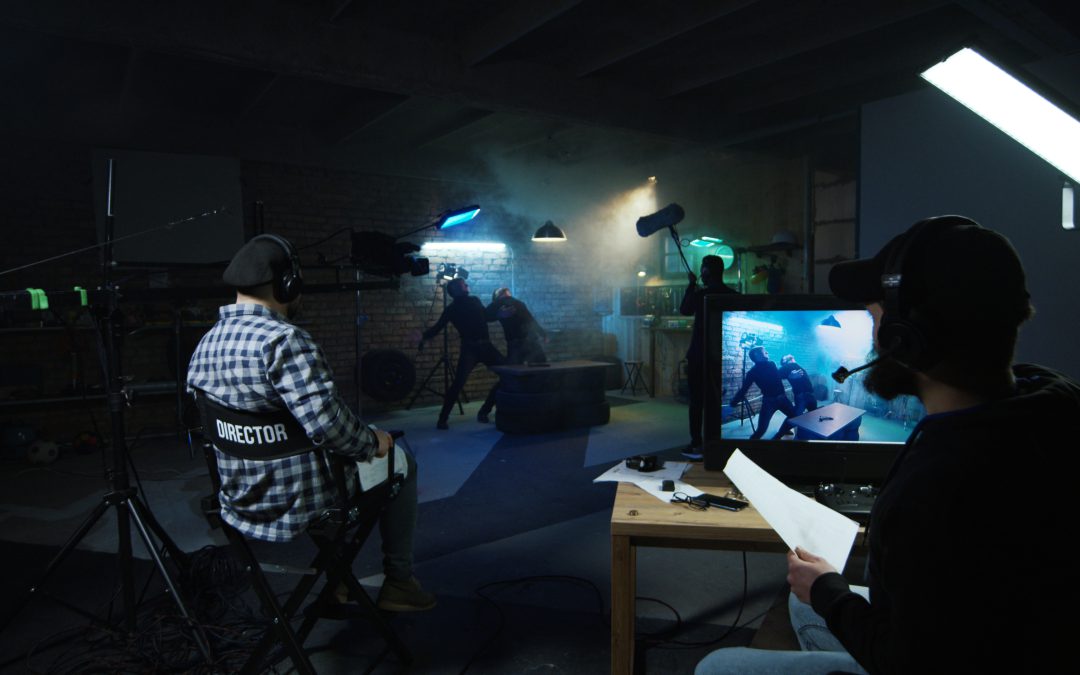
Imagine a director saying that he wants to create a scene where dragons are blowing fire and flying over the streets of New York City. Any guesses on what a VFX artist would reply in this situation? He’d say ‘’It's a brilliant idea, hold my coffee!
Well, that’s possible. Bringing a wild idea like that into reality is possible when there is an epic collaboration between a director and a VFX team. After all, they own the creative team tag! This synergy can enhance storytelling, create an emotional impact, push creative boundaries, and leave audiences mesmerized by turning their blank screens into jaw-dropping galaxies!
The collaboration between a director and a VFX team starts from the pre-production phase and lasts till the post-production phase, however, there is a lot of work that goes in between. In this blog, we shall explore and learn more about this interesting co-creation.
The Director’s Kickoff: Setting the Creative Tone
In shaping the overall vision of a film, the director plays a pivotal role. From guiding through the story, style, and tone to the emotional depth–this whole scenario is crafted by a director. However, a director alone cannot do this. Apart from depending on the cinematographers, producers, and actors, directors heavily rely on the VFX team to bring their ambitious concepts to life.
For example, visionaries like James Cameron and Peter Jackson are great examples of directors who expertly collaborated with the VFX team to create masterpieces. Cameron’s Avatar showcased breathtaking worlds while Jackson immersed us in the epic battle scenes from The Lord of the Rings.
The Early Collaboration of the VFX Team and Directors
After setting the tone for a film, the next step is a process called pre-visualization. This is the foundation of any scene and begins the collaboration of the VFX team and the director. Here is what happens next:
- With previsualization, the VFX team and the director visualize key scenes before the shooting begins while aligning others' creative visions.
- Storyboards, shot lists, or animatics are created which enables directors to experiment with lighting and camera angles–this drives innovation and collaboration. Watch this video to learn a little more about the pre-visualization process.
This stage of coordination between the VFX team and the director is crucial, as both creativity and concerns can be addressed. It also initiates informed decisions and clear communication, minimizing misunderstandings and setting the stage for seamlessly blending execution and imagination.
VFX Team: Crafting Ideas for Life
The VFX team are indeed the heroes behind transforming the director's visions into jaw-dropping realities on screen. By using creativity and technical expertise, raw footages are enhanced with visual effects like CGI and digital composting.
Here, the role of a VFX team goes beyond technical execution. They work closely with directors to help maintain the balance between fantasy and realism, to ensure the visual effects stay true to the story's line. This collaboration allows a smooth transition of bringing visions to the screen, all while captivating the audience and elevating the cinematic experience. This video explains how the VFX team creates magic!
While the technical and storytelling aspects are set up, another crucial stepping stone in this collaboration is the clear communication between the VFX team and the director. Real-time collaboration is of immense importance as it helps troubleshoot unexpected challenges. It also ensures that the director's vision including technical constraints aligns with both, practical and visual aspects.
The Final Collaborative Stage
The final post-production stage is where collaboration is still the key to creating a seamless, cinematic experience. At this stage, the visual effects go through an iterative process of tweaks, reviews, and enhancements to align with the director's vision. Meanwhile, other artists like the sound and light artists add their inputs to ensure a cohesive and polished look. Together, the director, the VFX team, and the editors meticulously transform raw footage into a scene that has an emotional impact and resonates with the audience. Watch one of the best VFX artists explain putting together the last bits of a scene.
Wrap-Up
This journey that began at the pre-production stage and lasted till the post-production stage has now come to an end. The strong collaboration between a director and a VFX team can really make a paramount difference. We at Knack Studios understand this rollercoaster of a journey, so team up with us and let’s bring your wildest visions to life!
What Is AI-powered VFX And How It’s Transforming Visual Storytelling
16th December, 20245 Mins

For decades, traditional VFX involved intensive, detailed manual work such as animating frame by frame, blending miniatures, and spending hours on tasks. There were no options for advanced visual technology like bringing late actors back on screen.
But now, AI-powered VFX is flipping the script, pushing the boundaries of creativity.
Filmmakers can now work faster, more efficiently, and with greater precision, unlocking possibilities that were once out of reach. In this article, we’ll explore how AI VFX is changing visual storytelling.
What exactly is AI-powered VFX?
AI in Visual Effects (VFX) means using AI tools to perform or improve specific operations within the VFX workflows. Earlier, VFX entailed the tedious process of drawing, modeling, and creating animations of visual components in movies, series, computer games, and other projects. However, AI uses machine learning, computer vision, and deep learning to enhance the VFX process and make it faster and more efficient.
One good AI VFX example is the Tamil movie ‘Weapon’ directed by Guhan Senniappan. In this movie, actor Sathyaraj, famous for his role as Kattappa in the Baahubali films, was de-aged using the AI VFX techniques.

The VFX artists even applied AI to enhance the skin tone of the 68-year-old actor, remove wrinkles, and make the face of the actor young again. The transformation in this film was so convincing that people were simply astonished to see Sathyaraj, who indeed looked like he did in his younger ages.
Traditional VFX Vs. AI-Powered VFX
Visual effects (VFX) have evolved from traditional practical effects to digital innovations. Earlier, traditional VFX involved manual work with miniatures, makeup, green screens, and complex animation. Artists spent hours on tasks like rotoscoping and compositing (isolating elements from video and combining them into a final scene) to create realistic effects, which was time-consuming and resource-heavy.
AI-powered VFX, however, has transformed this process. AI automates tasks like motion tracking, background removal, and even de-ageing actors using machine learning and deep learning. This speeds up the process and improves precision and accuracy, reducing human error. AI makes it possible to develop effects and simulations in minutes, thus freeing filmmakers and increasing productivity.
In contrast, traditional VFX was time-consuming, expensive, and a one-man show, but artificial intelligence has made it more efficient. As AI technology advances, we can expect even more groundbreaking possibilities in visual storytelling.
Why Studios Love AI-Powered VFX
AI-powered VFX is rapidly changing the entertainment industry, providing studios with powerful tools to tackle complex challenges. One prime example is Pixar’s Elemental, where AI was used to stylize fire simulations. VFX supervisor Sanjay Bakshi and his team turned to a machine learning technique called “neural style transfer” to align fiery characters with director Peter Sohn’s vision.

Traditional methods struggled with the dynamic nature of fire, as it constantly changes and requires highly realistic simulations. By applying AI, the team could stylize the flames without losing their natural, fluid movement.
This innovation highlights why studios love AI-powered VFX: it enables them to solve problems that were once thought impossible. AI offers faster, more precise results, while also maintaining the artistry of traditional techniques.
Real-World VFX Examples in Visual Storytelling
AI-powered VFX has given us some of the most unforgettable visuals in recent cinema, transforming the way stories are told. Let’s break down a few remarkable VFX examples of AI at work:
De-aging and Face Replacement: The film Here, directed by Robert Zemeckis, utilized generative AI to de-age actors Tom Hanks and Robin Wright, portraying their characters across 60 years. The technology allowed for real-time facial transformations during filming
Virtual Characters: AI has played a key role in creating lifelike film characters.
In the movie GOAT directed by Venkat Prabu, AI was used to bring back the late actor Vijayakanth, utilizing de-ageing techniques for his flashback scene. This was accomplished through advanced visual effects and AI-driven de-aging techniques, which recreated the actor's younger self with stunning realism for a flashback sequence.
The process involved blending AI tools, deep learning algorithms, and artistic input from VFX experts. AI was used to analyze extensive archival footage and photographs of Vijayakanth from his prime, enabling the creation of a detailed digital replica of his facial expressions, mannerisms, and iconic screen presence. With this digital recreation coupled with the live-action footage, audiences can relive the charisma of one of Tamil cinema's legendary actors.
Wrapping It All Up
AI-powered VFX redefines what’s possible in filmmaking, making ambitious visions a reality while saving time and costs. For studios, the benefits are clear—cost efficiency, streamlined workflows, and the ability to tackle intriguing projects.
With a strong foundation in advanced VFX technology, Knack Studios is helping filmmakers transform ambitious ideas into on-screen realities that captivate audiences. If you are ready to bring your ideas to life, Work with us at Knack Studios!
3D Animation Simplified: A Beginner’s Guide
23rd December, 20245 Mins

Ever watched the Toy Story franchise and wondered how a bunch of ordinary toys were brought to life with such personality and charm? From Woody tipping his hat to Buzz Lightyear soaring “to infinity and beyond,” how do you think these iconic characters do that with such style, emotions, and realism?

The magic lies in 3D animation - a blend of artistry and technology that turns dreams and imaginative ideas into lifelike visuals. 3D animation is a key aspect of a film’s post-production process where every detail is crafted to immerse you in a magical world.
If you’ve ever wanted to peek behind the curtain of this incredible element of filmmaking, this guide will show you how imaginative and colourful worlds are built from scratch! Let’s jump in and get started!
Differences Between 2D and 3D Animation
At its core, 3D animation involves creating digital characters, objects, and environments in a three-dimensional space. It uses virtual models and assets that can be digitally manipulated to move or interact in lifelike ways, unlike 2D animation, which involves drawing movements frame by frame. Here are some other ways on how they differ:

How are 3D animations Created?
There are a few key steps in 3D modelling, from initial modelling to rendering them into a finished video. Typically like any other mode of visual storytelling, the entire process begins with ideation, followed by sketching and storyboarding. They serve as the creative foundation, where concepts come to life, bridging the gap between imagination and execution. Once these steps are complete, the technical process of 3D animation starts from:
Modelling
The 3D animation process starts with modelling the characters, objects, and environments that will appear in the animation. Here, animators use specialised softwares such as Autodesk Maya, Blender, Houdini, etc. to create detailed, three-dimensional shapes out of lines, curves, and polygons.
Shakti Soundar Rajan’s Teddy, a 2021 Tamil fantasy action film, used 3D animation and motion capture to create a fully digital character with lifelike movements and expressions. You can go behind the scenes and check out the entire process by clicking here.
Rigging
Did you know that Frozen (2013) used 312-character rigs, 245 clothing rigs, and 63 hair rigs?
Rigging is where animators add a virtual skeleton to the models to control their movements. It is a critical step in 3D animation as it provides the framework for characters and objects to move realistically and allows animators to manipulate their movements and facial expressions efficiently.
The virtual skeleton is a hierarchical system of interconnected joints, also known as a rig and has been used extensively in animating Elsa’s graceful movements in Frozen. Rigging also saves time from having to tweak individual components frame by frame and even allows for reuse in multiple animations.

Staging & Animation
In this phase, animators use computer programs to place each 3D character and object into their respective scenes and determine how they move and interact with one another. Using softwares like 3ds Max, Houdini, and Maya, they set keyframes, which mark the start and end points of each movement, followed by filling the frames of motion in between. Once the animation is finalized, lighting and camera angles are adjusted to make the scene more compelling. Circling back to Toy Story, Woody’s and Buzz Lightyear’s dynamic interactions are given life through staging and animation. You can check out the film’s animation process by clicking here.

Rendering
In the art of filmmaking, the rendering process plays a crucial role in delivering the final animation into post-production. At this stage, the main process of developing 3D animation ends, followed by the addition of visual and sound effects, music, and voice-over. After this, the final scene is rendered by the software frame-by-frame, which can be incredibly time-consuming and take up several hours. Once rendering is complete, the final animation is converted into a viewable video file.
Wrapping Up
And there you have it - a peek into the magical world of 3D animation where creativity and technology join hands to transform simple ideas into epic cinematic moments. From the whimsical world of Toy Story to the icy splendor of Frozen, each frame tells an impactful story that can linger with us long after the credits roll. And if you’ve ever dreamt of telling your own animated story, look no further as Knack Studios can help you bring your creative vision to life that captivates, inspires, and leaves a lasting impression.Contact us today if you’d like to know more about our services in the area of 3D animation.
More Blogs
 Sound
Sound
2nd January, 2025 5 mins
The Role of Sound in Cinematic Storytelling
 Post Production
Post Production
9th October, 2024 6 minutes
Tech Talk With Knack: The Future of Post-Production: Trends to Watch in 2024
 Animation
Animation
23rd October, 2024 5 minutes
What Is Computer Generated Imagery (CGI) in Movies? The Art of Creating Still or Animated Visual Content
